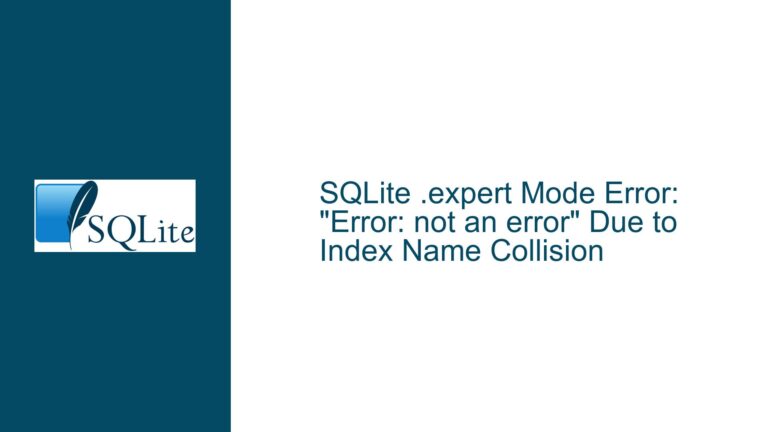and Reducing FTS5 Index Size in SQLite
FTS5 Index Size Ballooning Beyond Expected Limits
When working with Full-Text Search (FTS) in SQLite, particularly the FTS5 module, one common issue that arises is the unexpected growth in the size of the FTS index. This can be particularly problematic when dealing with large datasets, such as email corpora, where the index size can balloon to many times the size of the original data. The core of the issue lies in understanding how FTS5 constructs its index, the impact of the data being indexed, and the configuration options available to control the size of the index.
In a typical scenario, you might start with a database that contains metadata but no full-text index. When you add an FTS5 index, the size of the database can increase dramatically. For example, a database that was originally 27 MB might grow to 11 GB after adding an FTS5 index. This is not just a matter of storage space; it can also impact the performance of queries and the efficiency of backups and data migrations.
The size of the FTS5 index is influenced by several factors, including the nature of the data being indexed, the configuration of the FTS5 table, and the presence of binary or non-text data within the corpus. Understanding these factors is crucial to diagnosing and resolving issues related to index size.
Binary Data Ingest and FTS5 Index Bloat
One of the primary causes of unexpected FTS5 index size growth is the inadvertent ingestion of binary data. When binary data is mistakenly treated as text and indexed by FTS5, it can lead to a significant increase in the size of the index. This is because FTS5 is designed to tokenize and index text data, and when it encounters binary data, it may create a large number of meaningless tokens, each of which is stored in the index.
In the case of an email corpus, binary attachments or other non-text elements within the emails can be mistakenly ingested as text. This can happen if the ingest process does not properly filter out binary data before it is passed to the FTS5 indexer. The result is an index that is much larger than necessary, as it contains entries for binary data that will never be searched.
To diagnose this issue, you should carefully review the ingest process to ensure that only text data is being passed to the FTS5 indexer. This may involve adding additional filtering steps to remove binary data or other non-text elements before they are indexed. Additionally, you can use tools like sqlite3_analyzer to examine the contents of the database and identify any tables or indexes that are unexpectedly large.
Optimizing FTS5 Index Size with Configuration and Maintenance
Once you have ensured that only text data is being indexed, there are several steps you can take to optimize the size of the FTS5 index. One of the most effective ways to reduce the size of the index is to use the detail option when creating the FTS5 table. The detail option controls the amount of information stored in the index, and setting it to none can significantly reduce the size of the index. However, this comes at the cost of some search functionality, as the index will no longer store positional information for tokens.
Another important step is to run the OPTIMIZE command on the FTS5 table. This command reorganizes the index to remove any redundant or unnecessary data, which can help to reduce its size. The OPTIMIZE command should be run periodically, especially after large data ingestions or deletions, to keep the index size in check.
Finally, running a VACUUM command on the database can help to reclaim any unused space and reduce the overall size of the database file. The VACUUM command rebuilds the entire database file, which can be time-consuming for large databases, but it is an effective way to ensure that the database is as compact as possible.
In summary, the key to managing FTS5 index size is to ensure that only text data is being indexed, to use the appropriate configuration options when creating the FTS5 table, and to perform regular maintenance tasks like OPTIMIZE and VACUUM. By following these steps, you can keep the size of your FTS5 index under control and ensure that your database remains efficient and performant.
Detailed Analysis of FTS5 Index Size and Optimization Techniques
To further understand the factors that contribute to FTS5 index size and how to optimize it, let’s delve deeper into the mechanics of FTS5 indexing and the impact of different configuration options.
FTS5 Index Structure and Data Storage
The FTS5 module in SQLite creates an inverted index, which maps tokens (words) to the documents that contain them. This index is stored in a series of tables within the SQLite database, and the size of these tables can vary depending on the amount of data being indexed and the configuration options used.
When you create an FTS5 table, you can specify various options that control how the index is constructed. One of the most important options is content, which determines whether the original content is stored within the FTS5 table or in an external table. If the content is stored externally, the FTS5 table will only contain the index, which can reduce its size. However, this also means that the original content must be retrieved from the external table when needed, which can impact query performance.
Another important option is detail, which controls the amount of information stored in the index. The detail option can be set to full, column, or none. Setting detail to full stores the most information, including the position of each token within the document, which allows for more advanced search functionality but also increases the size of the index. Setting detail to none stores the least information, which reduces the size of the index but limits the search functionality.
Impact of Binary Data on FTS5 Index Size
As mentioned earlier, the inadvertent ingestion of binary data can significantly increase the size of the FTS5 index. This is because FTS5 is designed to tokenize and index text data, and when it encounters binary data, it may create a large number of meaningless tokens. Each of these tokens is stored in the index, which can lead to a significant increase in size.
To avoid this issue, it is important to ensure that only text data is passed to the FTS5 indexer. This may involve adding additional filtering steps to the ingest process to remove binary data or other non-text elements before they are indexed. Additionally, you can use tools like sqlite3_analyzer to examine the contents of the database and identify any tables or indexes that are unexpectedly large.
Optimizing FTS5 Index Size with Configuration Options
There are several configuration options that can be used to optimize the size of the FTS5 index. One of the most effective options is detail, which controls the amount of information stored in the index. Setting detail to none can significantly reduce the size of the index, but it also limits the search functionality. For example, with detail set to none, you will not be able to perform phrase searches or proximity searches.
Another option is content, which determines whether the original content is stored within the FTS5 table or in an external table. If the content is stored externally, the FTS5 table will only contain the index, which can reduce its size. However, this also means that the original content must be retrieved from the external table when needed, which can impact query performance.
Maintenance Tasks to Reduce FTS5 Index Size
In addition to configuration options, there are several maintenance tasks that can be performed to reduce the size of the FTS5 index. One of the most important tasks is to run the OPTIMIZE command on the FTS5 table. This command reorganizes the index to remove any redundant or unnecessary data, which can help to reduce its size. The OPTIMIZE command should be run periodically, especially after large data ingestions or deletions, to keep the index size in check.
Another important task is to run a VACUUM command on the database. The VACUUM command rebuilds the entire database file, which can reclaim any unused space and reduce the overall size of the database file. While the VACUUM command can be time-consuming for large databases, it is an effective way to ensure that the database is as compact as possible.
Practical Example: Reducing FTS5 Index Size in an Email Corpus
To illustrate the impact of these optimization techniques, let’s consider a practical example involving an email corpus. Suppose you have a database that contains metadata for 80,000 emails, and you want to add an FTS5 index to enable full-text search on the email bodies.
Initially, the database without the FTS5 index is 27 MB in size. After adding the FTS5 index with default settings, the database size balloons to 11 GB. This is a significant increase, and it is likely due to the inadvertent ingestion of binary data within the email corpus.
To address this issue, you first review the ingest process and add additional filtering steps to remove binary data before it is passed to the FTS5 indexer. After re-ingesting the data, the database size is reduced to 283 MB, which is a significant improvement.
Next, you optimize the FTS5 index by setting the detail option to none and running the OPTIMIZE command. This further reduces the size of the index, and running a VACUUM command reclaims any unused space, resulting in a final database size of 270 MB.
Conclusion
Managing the size of an FTS5 index in SQLite requires a combination of careful data ingestion, appropriate configuration options, and regular maintenance tasks. By ensuring that only text data is indexed, using the detail and content options to control the amount of information stored in the index, and performing regular OPTIMIZE and VACUUM operations, you can keep the size of your FTS5 index under control and ensure that your database remains efficient and performant.
In summary, the key to managing FTS5 index size is to:
- Ensure that only text data is being indexed by carefully filtering out binary data during the ingest process.
- Use the
detailoption to control the amount of information stored in the index, setting it tononeif advanced search functionality is not required. - Use the
contentoption to store the original content externally, reducing the size of the FTS5 table. - Run the
OPTIMIZEcommand periodically to reorganize the index and remove redundant data. - Run the
VACUUMcommand to reclaim unused space and reduce the overall size of the database file.
By following these steps, you can effectively manage the size of your FTS5 index and ensure that your SQLite database remains efficient and performant, even when dealing with large datasets.






